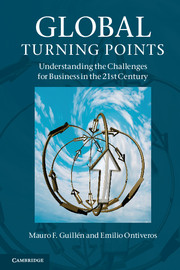Book contents
- Frontmatter
- Contents
- Illustrations
- Tables
- Preface
- 1 Welcome to the twenty-first century
- 2 A global economy out of balance
- 3 The rise of the emerging-market multinationals
- 4 The new demography
- 5 From dictatorship to democracy and failed states
- 6 A disparate world
- 7 The quest for sustainability
- 8 The global powers of the twenty-first century
- 9 Coping with uncertainty and complexity
- References
- Index
9 - Coping with uncertainty and complexity
- Frontmatter
- Contents
- Illustrations
- Tables
- Preface
- 1 Welcome to the twenty-first century
- 2 A global economy out of balance
- 3 The rise of the emerging-market multinationals
- 4 The new demography
- 5 From dictatorship to democracy and failed states
- 6 A disparate world
- 7 The quest for sustainability
- 8 The global powers of the twenty-first century
- 9 Coping with uncertainty and complexity
- References
- Index
Summary
We have documented in previous chapters the key economic, socio-demographic, political, and geopolitical global turning points. Taken as a whole, these points of inflexion define the ways in which the twenty-first century is so tantalizingly mercurial, uncertain, and complex when compared to the twentieth. Table 9.1 summarizes the turning points as well as the key drivers and consequences.
As far as the economy and business are concerned, the key turning points into the twenty-first century have to do with the rise of the emerging economies. By the end of the second decade of the new century, more than half of global output will be accounted for by emerging and developing countries. These economies are also positioning themselves as big exporters of commodities, manufactured goods, and services. This turning point is driven by differentials in growth rates for both GDP and population. A second, related turning point has to do with the fact that emerging and developing countries have come to own more than half of total foreign exchange reserves in the world, a shift fueled by their large current account surpluses. They are also blessed by historically low levels of external debt, which implies that they enjoy an unprecedented capacity to invest abroad. Emerging and developing countries have actually become a key source for the funding needs of developed economies.
- Type
- Chapter
- Information
- Global Turning PointsUnderstanding the Challenges for Business in the 21st Century, pp. 149 - 164Publisher: Cambridge University PressPrint publication year: 2012



